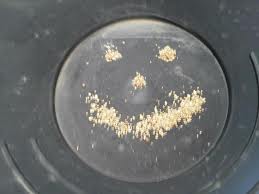
Spitskop sticking out behind young Pine Trees
One of the Spitzkop diggers was particularly famous. He was an individual named John Swann. He had made a rich strike somewhere near Spitzkop, but always kept it a close secret. Working on his own at night, he contrived to recover enough gold to finance his own activities, although he had to take his ore some miles to water.

Gold Nugget

Abandoned Typical Water Wheel & Stamp Battery Used
Then, like a bolt from the blue, the French company Messrs Guilband & Co obtained their concession over Spitzkop. Swann’s race, by then, after four years’ work, was about two-thirds finished and about sixteen miles long. He had hoped to complete it by 1886. Now all his hopes collapsed. The company offered him some compensation and a twenty percent interest if he would show them his strike. He refused. Like most of his fellows, he felt that he had been cheated out of a fortune by the monopolists and concessionaires.

Barberton Mountains
In bitterness of soul, he packed his belongings and abandoned his treasured strike and his water race, the most famous ever made by any digger. He removed to the Kaap Valley and prospected with James Simpson. All he found, unhappily, was death. Fever caught him. When he lay dying, Simpson begged him for the secret of his strike. John Swann just gritted his teeth and turned his face to the wall.

Gold Specks in a Pan

Gold Panning Advert
‘ It’s good,’ he muttered,’ It’s rich, but it’s deep, They’ll never get it.’
That was the end. His strike was never found. The race still remains, a seemingly endless trench meandering around the hills, and reaching a disconsolate end within a stone’s throw of the modern road down Ross Hill to the town of Sabie.
A Snippet from “Lost Trails of the Transvaal”, by T.V. Bulpin

Trips ZA Logo
Call our Dream Merchants at TRIPS ZA for exciting History, Wildlife, Scenic or General Interest Tours in the Panorama and Kruger regions or beyond on
013 764 1177.
Email us at johnt@tripsza.com
